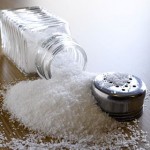 Yes, it’s true that a little bit of healthy fats and even a little salt can be good for your health and bodily function. However, excessive amounts of both can be extremely detrimental to your weight loss goals, and overall health and well being.
Yes, it’s true that a little bit of healthy fats and even a little salt can be good for your health and bodily function. However, excessive amounts of both can be extremely detrimental to your weight loss goals, and overall health and well being.
Salt consumption tends to be a tricky topic, as it is used as both an ingredient and a condiment. Further complicating the issue is how salt is labeled and added to processed foods…often times, it’s commonly renamed: monosodium glutamite, disodium phosphate, baking soda, and sodium citrate – all of these are forms of salt that are often added to processed foods and condiments to enhance flavor and help preserve food for longer shelf life.
As a general rule, if trying to limit salt intake, then avoid these foods:
- CANNED vegetables, soups, sauces, dressings, meats and condiments (ketchup, soy sauce, etc.)
- PREPARED frozen foods and entrees
- PACKAGED mixes and powders
- FRIED foods
For ways to reduce salt and season your food with other spices, try some of these ideas:
- When making soups or stews, always use low sodium broths and/or a combination of low sodium broth and water. You’ll still add a lot of flavor but will greatly decrease your sodium intake.
- Make your own tomato sauce, or find an option with no added salt (or sugar!). Tomato sauce can be a really low calorie, flavorful way to enhance your meal, but it can also be a hidden source of sodium, fat, and extra calories if you’re not careful.
- Go to specialty or health food stores to check out some seasoning blends that don’t have any added salts. One of our favorites? Herbs de Provence, which is a French blend of herbs like marjoram, thyme, oregano, rosemary, and lavender.
- Try cooking your favorite ethnic cuisines at home. You can create your own Mexican meal, Italian flavors, or curry with a lot of spices and herbs. Use seasonings like chili powder, garlic powder, cumin, oregano, basil, parsley, and curry powder.
- Use low sodium or no added salt versions of things like salsa as an easy way to add a new flavor depth to fresh veggies, chicken, or salads.
- Citrus and vinegars make huge flavor boosters with minimal added calories. Don’t be afraid to try fun vinegars like a pomegranate vinegar, or a raspberry balsamic vinegar.
Try some of these tips for how to cook your food without adding extra fat:
- Want a fried egg? Try using a nonstick skillet, and then pouring in a couple tablespoons of water and covering with a lid. The water will prevent the egg from sticking, and the steaming effect is much healthier than frying in a couple tablespoons of butter!
- Roast it up! Roasting anything, from chicken or fish to vegetables really brings out the flavor of what you’re cooking. You can use no fat at all, or just a teaspoon or so of an oil with a high smoke point, like canola oil or grape seed oil. Bonus? You can roast your protein and your vegetables all at the same time, making dinner prep easier for you.
- Steam your veggies! You can buy a steamer basket relatively inexpensively at many stores. All you have to do is fill the bottom of a pot with a couple inches of water (below the steamer basket), then place the vegetables on top of the basket. This technique takes no more than a few minutes, has no added fat, and retains most of the nutrients.
- Bake, don’t fry. Even typically unhealthy foods like French fries and chicken tenders can get a healthy makeover if you bake them. Try dipping chicken breast strips in egg whites and whole wheat bread crumbs or almond meal, then bake. For a homemade sweet potato fry, slice sweet potatoes into fry-like shapes and liberally coat with chili powder, garlic powder, and cinnamon. Bake at a high temperature, and you won’t miss their fried counterpart at all!
- If you’re sautéing vegetables or protein and they’re looking a little dry or sticking to the pan, try adding a splash of low sodium broth instead of extra fat. You’ll boost the flavor a lot and won’t add a lot of extra sodium or any fat.
- Try poaching things like eggs or chicken breasts. You’re just cooking them in a water bath, and they’ll retain a lot of moisture and have no added fat.
Don’t be afraid to get creative, either! Play around with some of these techniques next time you’re cooking, and eventually you’ll find which seasonings you really love.
